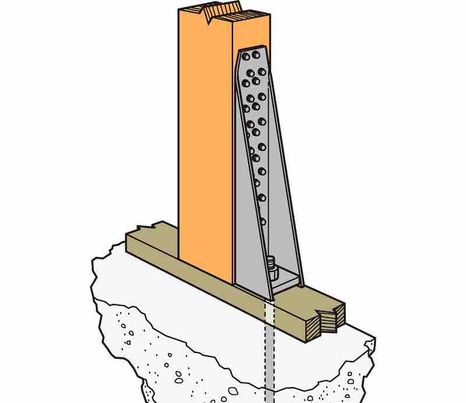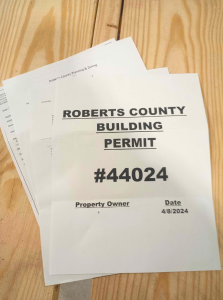Another great question from a loyal reader:
DEAR POLE BARN GURU: How would you install a concrete floor in one of your pole buildings. RICK in TOLEDO
DEAR RICK: Here is the chapter from the Hansen Pole Buildings Construction Manual:
Chapter 18: Concrete Slabs
While preference is to have building shell completed prior to pouring concrete slabs, at the very least, roof should be installed.
Building columns tend to grow “bull’s-eyes” in the presence of pre-mix concrete trucks. A completed building shell is far more resistant to potential damage. Pouring slabs with columns only in place, adds to the risk of one inadvertently being knocked out of plumb.
This section is not meant to provide the necessary instruction to pour a building slab. This is not because the task is beyond a novice’s abilities, although many do contract out this job. Pouring a slab is within most people’s abilities. However, unlike wood framing, which can be corrected if improperly constructed, work on a slab is “set in stone”. Due to this, and the fact so many local codes and practices apply to concrete slabs, we have only touched on this subject. If deciding to personally undertake, we suggest talking with local professionals to know what you are getting into. Have building inspector (usually a requirement in permitted situations) or a professional inspect work before pouring concrete. If under 100% confident, hire a professional to work alongside during the concrete pour.
If in “frost country” a sub-base 6” or thicker should be first placed across the site. To maintain frost-free soils sub-base should be such as no more than 5% (by weight) will pass the No. 200 sieve, and it is further desired no more than 2% be finer than .02 mm.
Prior to pouring, 2” to 6” of clean and drained sand or sandy gravel is spread below where concrete is to be poured. Mechanically compact fill to at least 90% of a Modified Proctor Density, so as not to cause slab to sink. ALWAYS install a good vapor barrier (such as A2V reflective insulation, available through Hansen Buildings) below any interior pour, to stop moisture from traveling up into slab through capillary action. Place 3” to 4” of clean and drained sand on top of the vapor barrier, to decrease differential drying shrinkage and floor curling. If not using fiber-mesh or similar reinforcement additives to concrete mixture, place wire mesh or rebar (reinforcing steel rods) in slab center to add rigidity to concrete to aid in minimizing cracking.
Insulation Underneath Concrete Slabs
Best product to use is A2V reflective insulation. Unroll reflective insulation over prepared site sand or gravel, with aluminum side facing ground (white side up). Overlap by 2” at seams. Run reflective insulation up skirt board inside by 6”. Seal seams with reflective insulation white vinyl tape or white duct tape. Pour concrete on top of reflective insulation.
Aluminum side faces away from the concrete as concrete’s high alkalinity attacks aluminum causing facing to degrade.
Adding sand over reflective insulation will facilitate water drainage during curing time and accelerate installation.
Local code will dictate such things as slab thickness (usually 4” nominal), wire mesh sizing, gravel or sand layer thickness, and size and rebar location. Many garage or shop slabs also have a center drain. In the event structural engineering for a concrete floor (or any concrete or other masonry footings, foundations, walls, or retaining walls) is required or requested by you, or a building official, this is outside our engineer’s scope.
On solid walls of building, pressure treated skirt board will serve as forms for pouring slab. In open wall areas, or across sliding or overhead doors, a 2×4 will need to be temporarily place as a form.
Prior to pouring a nominal 4” (3-1/2” actual completed) thick concrete slab in building, finished, graded compacted fill TOP will be even with skirt board BOTTOM. If a thicker floor is desired, excavate below skirt board bottom, by any slab thickness greater than 4”. In no case, will concrete floor top, be even with either top or skirt board bottom. Using any other measure for the concrete slab top, will result in wall steel and doors not properly fitting, as well as interior clear height loss.
In other terms – after the floor is poured, when standing inside building, approximately 3-3/4” of the skirt board will be visible above the top of the slab.
In the event a professional is hired to finish concrete, most often costs can be reduced by paying the local pre-mix company direct for the concrete. Many offer discounts for prompt payment, so do not be afraid to ask. On a properly leveled site, a pre-mix concrete yard will cover an 80 square feet area, nominally four inches thick.
Mike the Pole Barn Guru










I appreciate what you said about “frost country” and how concrete should be thicker when poured in such a climate. Personally, I think concrete pouring requires a solid level of expertise, and it’s always good to find a concrete service with a great reputation. My wife and I are thinking about putting in a basketball court in our yard, so we’ll be sure to contact a reliable service to help us pour a nice slab of concrete.
I like your tip about pouring a nominal 4 inches. That seems reasonable for creating a solid base. I’ll have to consider your tips so that I can pour concrete correctly.
As a concrete contractor I am surprised you did not already realize this.
I love your tip about using aluminum in the framework with the concrete. That seems like a good choice to make sure the concrete holds its form. I’ll have to consider hiring a concrete contractor to put an aluminum framework down for my driveway.
I am a contractor in Minnesota and just wanting your thoughts about using crushed rock as supposed to concrete around the posts. I am leaning towards pouring a 6 to 8″ base of concrete and doing crushed rock around posts just curious what you think of it. I have not done a pole barn for a long time and was just a laborer at that time, now i have a customer who wants 2 pole barns.
Crushed rock will do nothing to prevent uplift or over turning, without out measures being taken. Since you are planning upon pouring concrete as a footing, you should just float the columns in the holes and monopour a footing/bottom collar in combination. The engineer who seals the building plans can take all of these factors into account to provide a structurally sound design solution.
I am considering a 40×30 building for residential use and much of the work will be done myself. However, pouring the concrete slab is one thing that I will contract out. Not trying to get into specific area requirements, I am just trying to ensure that I am understanding this process, so please correct me if I’m wrong…
1) The building site will be marked, squared, and graded out to level; 2) the post holes will be marked and dug out; 3) posts will be placed in hole, checked for plumb, braced, concreted, and then backfilled with dirt; 4) allow time to cure, then set trusses; 5) install 2x girts, purlins, and skirt boards; 6) put up house wrap, roof vapor barrier, wall siding and roof metal; 7) pour in sand/gravel material, compact it, then install slab vapor barrier and rebar/steel reinforcement; 8) pour concrete
You have #1-3 spot on. In #4 I would install splash planks (skirt boards) so I have a clear point of reference for grade, then raise trusses. #5 would be to completely frame roof, install roof vapor barrier (although I would recommend an Integral Condensation Control) and roof steel. #6 would be wall framing, housewrap (unless using closed cell spray foam), windows and doors, siding. Depending upon your Climate Zone, you may need to insert placing rigid insulation boards around perimeter as well.
I plan to build a pole barn with a concrete floor.
I am putting the post in 48 inches and setting them in concrete.
Then I will put a skirt board around the posts for the concrete slab.
With this type of floor, will the slab need a footer?
As long as your slab is supporting no roof loads, there is no structural reason for it to have a footer.